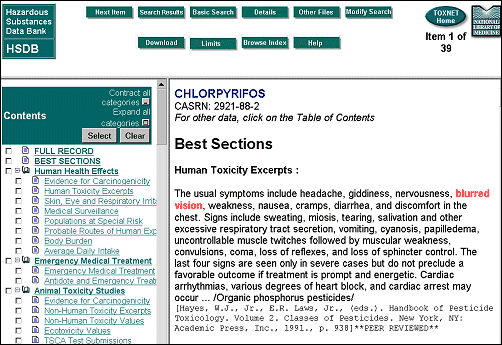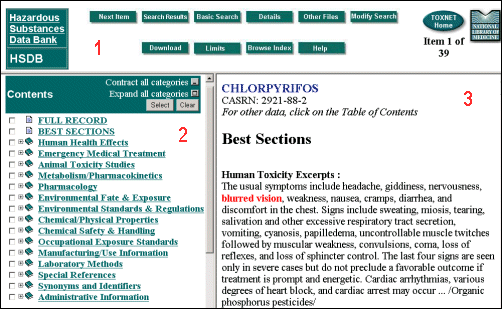 Skill Kit: Basic Searching of the Hazardous Substances Data Bank (HSDB®)
Skill Kit: Basic Searching of the Hazardous Substances Data Bank (HSDB®)
the National Library of Medicine® Toxicology and Environmental Health Information Program (TEHIP) has been developing resources to assist health professionals and scientists in their work for nearly 40 years. One of the TEHIP major resources is TOXNET®, a collection of databases on toxicology, hazardous chemicals, environmental health, and toxic releases. TOXNET includes the Hazardous Substances Data Bank.
What is the Hazardous Substances Data Bank (HSDB)?
The Hazardous Substances Data Bank (HSDB) is one of the primary databases in the NLM TOXNET system. It provides comprehensive peer-reveiwed toxicological data on over 5,000 substances. HSDB contains excerpts from the published literature on human health effects and exposure, emergency medical treatment, standards and regulations, safety and handling procedures, and environmental fate. All data in HSDB are referenced and derived from a core set of books, government documents, technical reports, selected primary journal literature, and electronic sources including the International Agency for Research on Cancer (IARC), the World Health Organization (WHO), and the American Conference of Governmental Industrial Hygienists® (ACGIH). HSDB is peer-reviewed by a Scientific Review Panel (SRP), a committee of experts in the major subject areas in the database's scope.
Quick Tour
An eight-minute animated tutorial demonstrating the features of this article is available. In addition to basic searching instruction covered in this article, you'll find useful techniques and tips.
Who uses HSDB and why?
Due to its technical nature, HSDB is most often used by health professionals, industrial hygienists, health information professionals, toxicologists, and chemists. The information in HSDB helps to improve understanding of research findings for health care workers and emergency responders, to assist family/friends who have health concerns, and to support the work of researchers in toxicology.
Searching HSDB
Search Example:
-
A pest control worker visits his family physician because he is experiencing blurred vision, sweating and nausea. In addition to the physical exam, the physician discusses the type of work the patient does, and what types of pesticides or chemicals he works with; the physician then searches HSDB for the chemical the worker used and a symptom: dursban blurred vision
The chemical record for Dursban® (chlorpyrifos) notes that common symptoms of exposure "include headache, giddiness, nervousness, blurred vision, weakness, nausea, cramps, diarrhea, and discomfort in the chest," and that "signs include sweating, miosis, tearing, salivation and other excessive respiratory tract secretion." The record also offers emergency medical treatment information and occupational exposure standards. See Figure 1.
Search Tips:
- For chemicals, HSDB automatically searches the term you entered, as well as synonyms and the Chemical Abstracts Service Registry Number.
- Use truncation (*), Boolean operators (AND, OR, NOT), nested parentheses, Limits, and index browsing to refine your HSDB search results.
- Multiple terms or concepts and phrases can also be searched. For example, searching "lung cancer" in quotes will retrieve all chemical records where the exact phrase lung cancer is found.
-
The HSDB "Limits" feature allows users to specify whether the search should be conducted for all the words, any of the words, or as a phrase, and whether the terms entered are searched as exact words, singular and plural forms, or word variants when multiple terms are entered.
HSDB Record
HSDB records are organized into three sections (see Figure 2):
- Navigation buttons - see #1 in Figure 2
Use the navigation buttons across the top of the screen to download the record, modify your search, move to another database, etc. - Contents - see #2 in Figure 2
In the left side bar the data in HSDB are organized into fifteen categories with over 150 fields (data elements). The Contents section allows you to navigate the lengthy HSDB records quickly to find the information you need. Click on any category or data element to move to that section of the chemical record.
The "Administrative Information" section provides information about each record's last revision date, last review date, and update history.
The entire record or other specific sections or categories can be viewed by clicking on them from the Table of Contents (Full Record).
- Chemical Data - see #3 in Figure 2
Scroll down in the main area on the right side of the screen to read the peer-reviewed toxicological information on the chemical. The data are displayed in the order of the Contents section on the left. HSDB provides comprehensive toxicological information on each chemical, so the records may be long. The average HSDB record is 25 printed pages.
Use the Contents on the left to navigate to specific categories within the record.
Relevancy Ranking
Relevancy ranking attempts to determine which records are most pertinent to the search, and to place the most relevant documents first in the list of returned records. The ranking is based upon the number of individual search terms occurring in a record, the number of times each search term occurs in a record, a term's rarity within the database, and the nearness of search terms to each other. Records containing combinations of search words tend to be ranked higher than records having isolated occurrences of the words.
Assistance
The Basic Searching of the Hazardous Substances Data Bank quick tour is an eight-minute demonstration of this information plus more search examples. The HSDB Help Section answers the most common questions you may have when you first start searching. The TOXNET FAQ also answers frequently asked questions, such as how to cite an HSDB record. If you need further assistance, email tehip@teh.nlm.nih.gov or call (301) 496-1131.
Basic Searching of the Hazardous Substances Data Bank (HSDB®). NLM Tech Bull. 2007 Mar-Apr;(355):e12.


